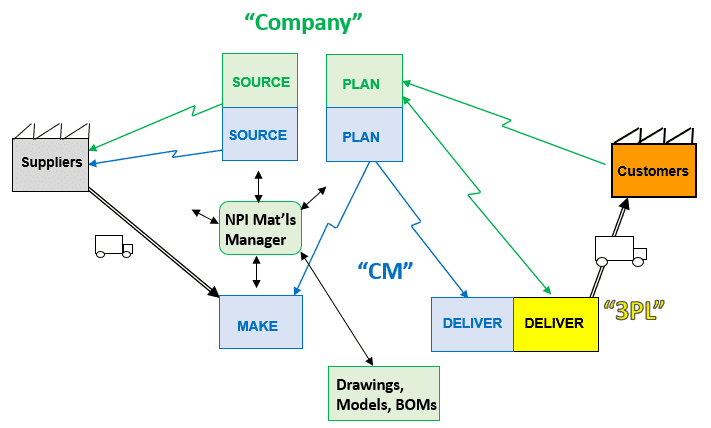Distinguishing Materials Management from Project Management
A sometimes overlooked function of production planning, is materials management for new product introduction (NPI).
In our previous article, we covered fundamentals of managing contract manufacturers (CM) value streams. The goal for NPI is similar: we want NPI prototypes available per a prototype plan and (eventually) a production plan.
Below is a simplified value stream map for a managing a contract manufacturer using “plan, source, make, deliver” as major subprocesses. The planning function “NPI Materials Manager” is shown with corresponding interfaces and is the focus of this article.

The goal of NPI materials management is to monitor and execute the desired item (part) and BOM status according to the NPI prototype and production plan.
This is best illustrated with the following categories and questions:
|
Plan
|
|
Sourcing & Suppliers: Source controlled components are commodities in which the source is controlled by the company for pricing negotiation (leveraging quantity buys) and superior quality (generally specialty components like cables/connectors, heat sinks, printed circuit boards, are purchased from specific suppliers).
|
|
Make (Suppliers):
|
|
Make (Contract Manufacturer):
|
|
Deliver:
|
The NPI Materials manager therefore becomes familiar with BOM items and item status according to several considerations:
- sourcing & suppliers (including alternate sources)
- lead times
- purchasing status (may also place purchase orders)
- configuration status (drawing/model release status, new PNs, revisions, obsolescence)
- where-used in BOMs and products (NPI, as well as existing production products)
- contract manufacturers (including alternate CMs)
This resource is therefore immersed in the ‘ecosystem’ of parts, ultimately becoming familiar with BOMS and parts (items) status and can function as the process owner for ensuring the status of parts known, and is integrated into NPI and production build schedules. The work effort for this resource can be significant, especially with a lengthy BOM, multiple NPI, production products and/or multiple CMs.
This resource also ensures continuity from NPI to production therefore is a function best centralized within Operations under Production Planning depending on your organizational structure. However, it’s important to ensure the NPI materials manager isn’t distracted from existing (sustaining) production support at the expense of effective NPI materials management.
With this in mind, NPI Project Managers (trained in the discipline of project management) are not necessarily managing part details, rather are managing tasks and deliverables across multiple functions according to the product lifecycle (PLC) process (such as engineering, test, manufacturing engineering, quality, CM operations, etc.) NPI PMs are often product line specific and might be considered internal customers of the NPI material manager.
Confounding NPI materials management with NPI project management can be a misallocation of resources and sub-optimize the management of the product lifecycle process.
Maintaining focus on parts status (NPI Materials Manager) vs. activities/deliverables (NPI Project Manager) with a healthy overlap can optimize new product introduction.
Recent Posts
Categories
- Agile (1)
- Change Management (2)
- Design for Six Sigma (3)
- Ideation (1)
- Lean Manufacturing (1)
- Lean Product Development (5)
- Maximizing Customer Value (3)
- Product Lifecycle Process (5)
- Project Governance (1)
- Project Management (9)
- Requirements Management (8)
- Roles and Responsibilities (3)
- Six Sigma (1)
- Supply Chain (1)
- Systems Integration (1)
- Uncategorized (12)
- Value Stream Management (5)
- Verification and Validation (6)
